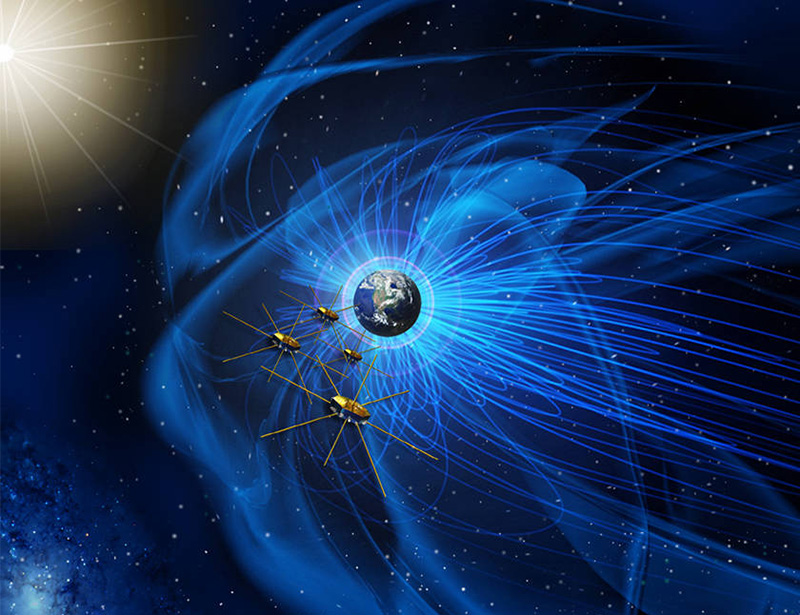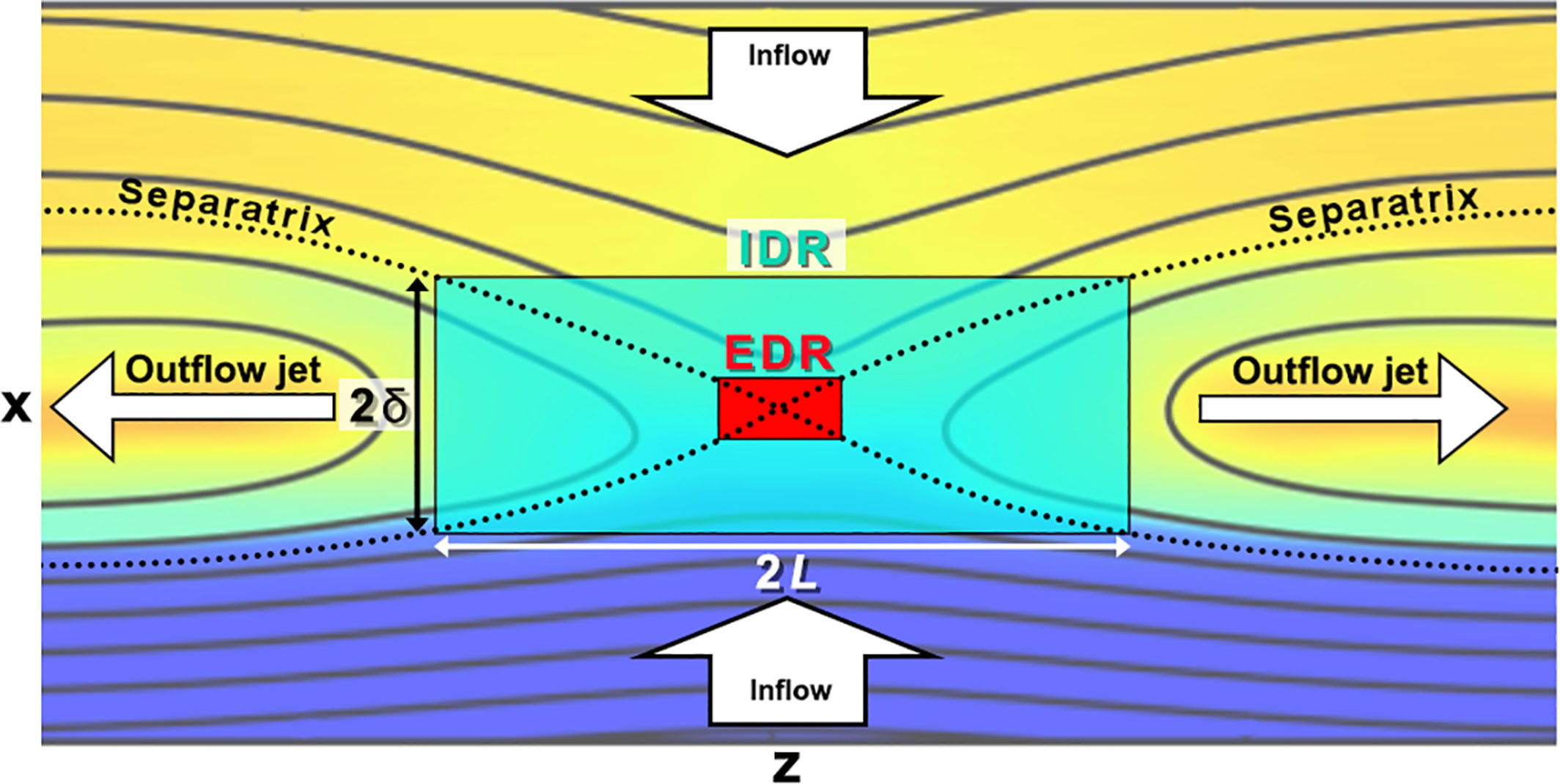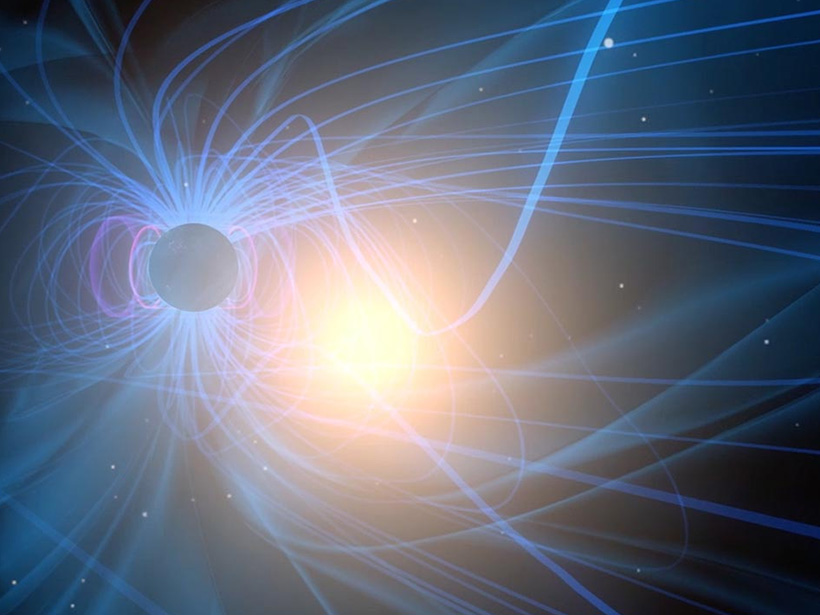The near-Earth space is filled with charged particles that come from two sources, the solar wind and the Earth’s upper atmosphere. A new article published in Reviews of Geophysics investigates the relative importance of the two sources of charged particles and their effects on plasma dynamics, especially the process of magnetic reconnection, which is responsible of coupling the Sun magnetic field to the Earth’s magnetic field. Here the authors explain what ionospheric ions are, what we understand about them, and what there is still to discover.
What are ionospheric ions and where do they come from?
Up in the higher altitudes of the atmosphere is the ionosphere where there are increasing number of charged particles ionized by the Sun’s radiation. These “ionospheric ions” reflect the make-up of Earth’s atmosphere: ionized hydrogen, oxygen, nitrogen, and helium can all be found in this region of space.
Electromagnetic processes can give some of these ions enough energy to escape the Earth’s gravity potential, and magnetic field lines guide these particles in their journey to outer space, where they are further energized.
If that escaping rate remained constant, it would take around 1,000 billion years to deplete the atmosphere.
Most of these particles do not go back to the atmosphere, and the net average escaping rate is roughly 5,250 tons per year.
This sounds like a large number, but it is actually a very small fraction of the Earth’s atmosphere. If that escaping rate remained constant, it would take around 1,000 billion years to deplete the atmosphere.
Although the loss of ionospheric ions is small, what impact do they have on near-Earth space?
The near-Earth space environment is known as the magnetosphere, i.e., the region where the Earth’s magnetic field dominates over the Sun’s magnetic field. The magnetosphere is like a magnetic bubble immersed in the heliosphere, the region where the Sun’s magnetic field dominates within the solar system. When certain conditions are met, the coupling between these two regions becomes very efficient, allowing large amounts of energy and particles from the Sun to enter the magnetosphere, generating geomagnetic storms and a variety of space weather phenomena.
The magnetosphere is constantly filled by particles from the solar wind and the Earth’s ionosphere.
The magnetosphere is constantly filled by particles from two sources: the solar wind and the Earth’s ionosphere.
The relative contribution of the two sources is variable and roughly of the same order of magnitude, but their properties are quite different.
Solar wind ions entering the magnetosphere are composed mainly of H+ ions and a few percent of He++ ions. Ionospheric ions are initially cold, i.e., have lower thermal energy than the solar wind, and often contain large amounts of O+ ions in addition to the much lighter H+ ions.
Ionospheric ions circulate in the magnetosphere following magnetic field convection and are the origin of various magnetospheric populations, including for instance plasmaspheric plumes or the warm plasma cloak. These populations eventually reach the interface between the magnetosphere and the solar wind, i.e., the magnetopause, and change its properties. Therefore, depending on the time-history (hours to days) of the solar wind and the magnetosphere, the magnetopause changes its location and properties, potentially affecting the efficiency of the coupling between the two regions.

How have recent observations and models advanced our understanding of the behavior of ionospheric ions?
The NASA Magnetospheric Multiscale (MMS) mission has revolutionized our understanding of magnetic reconnection, the main process at work for coupling the Earth’s magnetosphere to the solar wind. Its spatial and time resolution has enabled us to understand how different charged particle populations are energized by the reconnecting magnetic fields.
Thanks to that mission, combined with high-performance numerical modeling, we now understand much better how ionospheric ions modify the reconnection process at a microphysical level. Ionospheric ions circulating in the magnetosphere are accelerated at reconnection sites and constitute a significant sink of energy for the reconnection process. In addition, depending on the ion mass, initial energy, and where the ions are entrained in a reconnection site, different energization mechanisms, some of them more efficient than others, come into play.

What are some of the unresolved questions where further research, data gathering, or modeling is needed?
We still understand relatively little about how magnetic reconnection microphysics shapes the magnetosphere system as a whole.
We still understand relatively little about how these recent discoveries about magnetic reconnection microphysics shape the magnetosphere system as a whole.
The impact of cold ions is still an open field of research, as cold ions introduce a new length-scale and many plasma processes depend on the coupling between different scales.
The MMS dataset is continuously growing and only a portion has been extensively analyzed. Combining it with other mission datasets, such as for instance Cluster or THEMIS, to perform large statistical studies in the solar wind parameter space, will shed light about how the system reacts to ionospheric ions on a global scale.
Moreover, global 3D magnetospheric numerical models coupled to the ionosphere are very advanced nowadays and will also deepen our understanding of the global picture of ion circulation and energization in the magnetosphere in response to different kinds of solar activity.
There is yet another ionospheric population, which is even less understood: cold electrons. They also outflow from the ionosphere, and these are even harder to characterize than cold ions. Electrons play crucial roles on magnetic reconnection and wave generation in the magnetosphere. So far, because of the immense difficulty of observing these low-energy electrons, the effects of cold electrons remain largely unexplored.

—Sergio Toledo ([email protected]; ![]() 0000-0002-4459-8783), University of Murcia, Spain and University of Toulouse, France; Mats André (
0000-0002-4459-8783), University of Murcia, Spain and University of Toulouse, France; Mats André (![]() 0000-0003-3725-4920), Swedish Institute of Space Physics, Sweden; Nicolas Aunai (
0000-0003-3725-4920), Swedish Institute of Space Physics, Sweden; Nicolas Aunai (![]() 0000-0002-9862-4318), Laboratoire de Physique des Plasmas, France; Charles R. Chappell (
0000-0002-9862-4318), Laboratoire de Physique des Plasmas, France; Charles R. Chappell (![]() 0000-0002-1703-6769) Vanderbilt University, USA; Jérémy Dargent (
0000-0002-1703-6769) Vanderbilt University, USA; Jérémy Dargent (![]() 0000-0002-7131-3587), University of Pisa, Italy; Stephen A. Fuselier (
0000-0002-7131-3587), University of Pisa, Italy; Stephen A. Fuselier (![]() 0000-0003-4101-7901), Southwest Research Institute and University of Texas at San Antonio, USA; Alex Glocer (
0000-0003-4101-7901), Southwest Research Institute and University of Texas at San Antonio, USA; Alex Glocer (![]() 0000-0001-9843-9094), NASA Goddard Space Flight Center, USA; Daniel B. Graham (
0000-0001-9843-9094), NASA Goddard Space Flight Center, USA; Daniel B. Graham (![]() 0000-0002-1046-746X), Swedish Institute of Space Physics, Sweden; Stein Haaland (
0000-0002-1046-746X), Swedish Institute of Space Physics, Sweden; Stein Haaland (![]() 0000-0002-1241-7570), Max-Planck Institute for Solar Systems Research, Germany, University of Bergen and The University Centre in Svalbard, Norway; Michal Hesse (
0000-0002-1241-7570), Max-Planck Institute for Solar Systems Research, Germany, University of Bergen and The University Centre in Svalbard, Norway; Michal Hesse (![]() 0000-0003-0377-9673), NASA Ames Research Center, USA; Lynn, M. Kistler (
0000-0003-0377-9673), NASA Ames Research Center, USA; Lynn, M. Kistler (![]() 0000-0002-8240-5559), University of New Hampshire, USA; Benoit Lavraud (
0000-0002-8240-5559), University of New Hampshire, USA; Benoit Lavraud (![]() 0000-0001-6807-8494), University of Bordeaux, France; Wenya Li (
0000-0001-6807-8494), University of Bordeaux, France; Wenya Li (![]() 0000-0003-1920-2406), National Space Science Center, China; Thomas E. Moore (
0000-0003-1920-2406), National Space Science Center, China; Thomas E. Moore (![]() 0000-0002-3150-1137), NASA Goddard Space Flight Center, USA; Paul Tenfjord (
0000-0002-3150-1137), NASA Goddard Space Flight Center, USA; Paul Tenfjord (![]() 0000-0001-7512-6407), University of Bergen, Norway; and Sarah K. Vines (
0000-0001-7512-6407), University of Bergen, Norway; and Sarah K. Vines (![]() 0000-0002-7515-3285), Johns Hopkins University Applied Physics Laboratory, USA
0000-0002-7515-3285), Johns Hopkins University Applied Physics Laboratory, USA
Citation:
Toledo, S., M. André, N. Aunai, C.R. Chappell, J. Dargent, S.A. Fuselier, A. Glocer, D.B. Graham, S. Haaland, M. Hesse, L.M. Kistler, B. Lavraud, W. Li, T. E. Moore, P. Tenfjord, and S.K. Vines (2021), Hidden atmospheric particles sculpt near-Earth space environment, Eos, 102, https://doi.org/10.1029/2021EO163314. Published on 22 September 2021.
Text © 2021. The authors. CC BY-NC-ND 3.0
Except where otherwise noted, images are subject to copyright. Any reuse without express permission from the copyright owner is prohibited.

